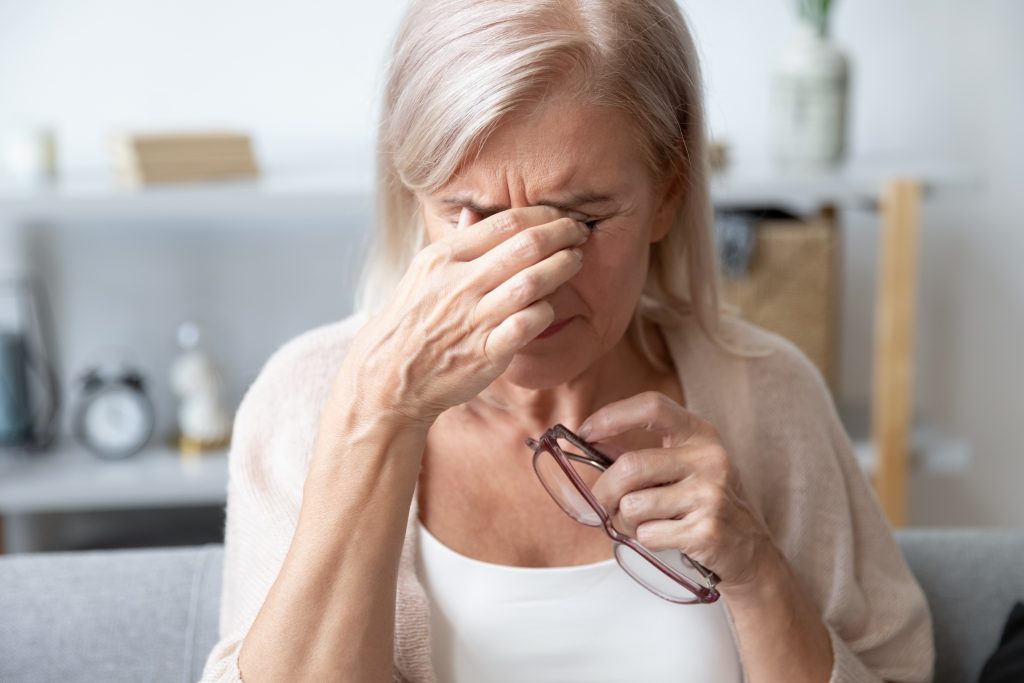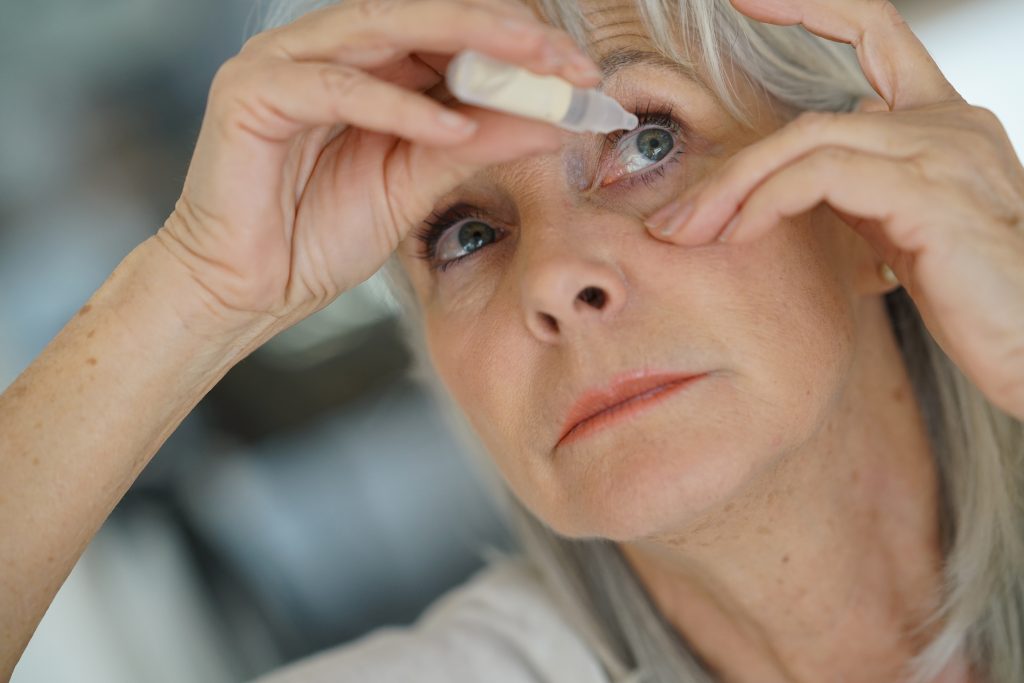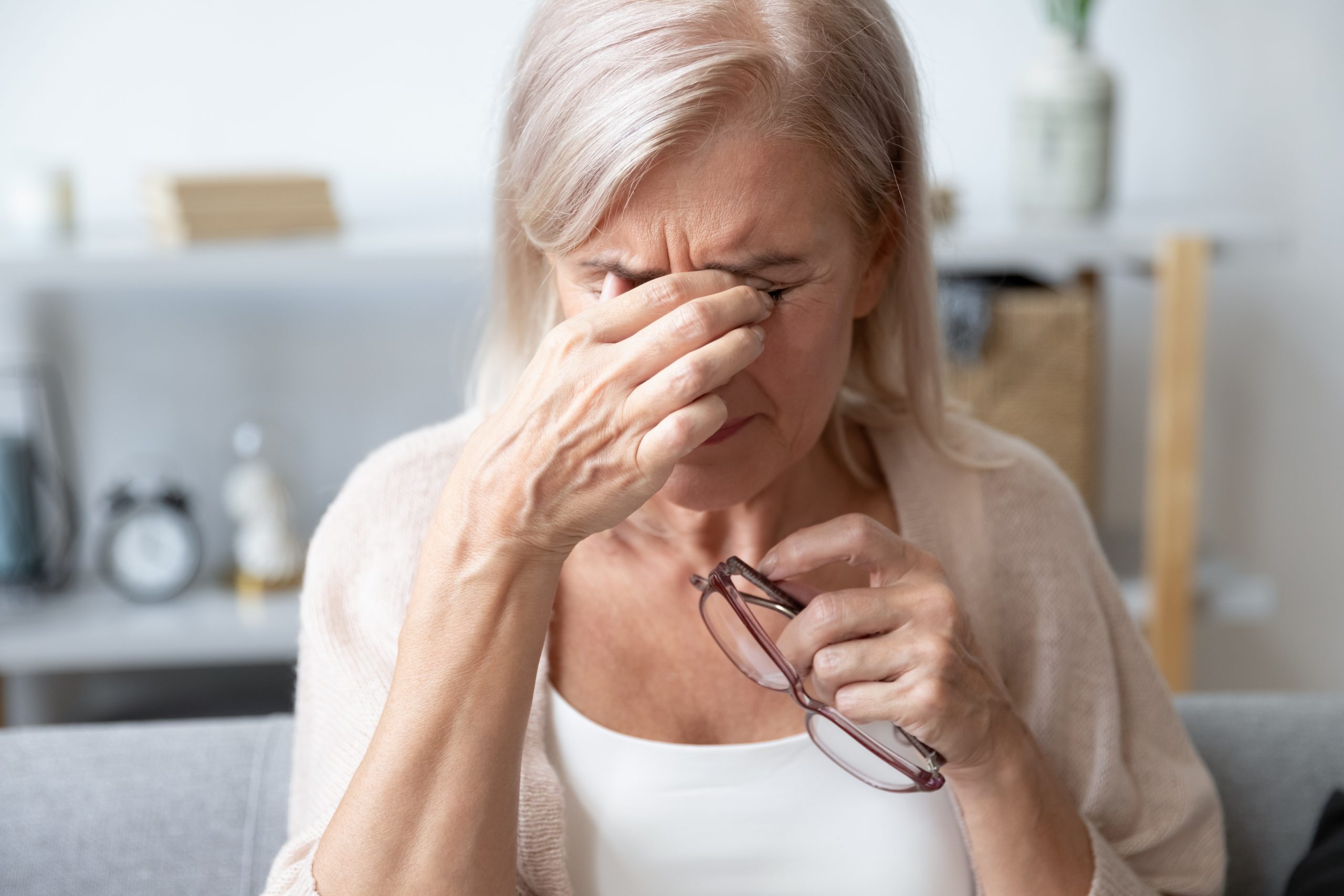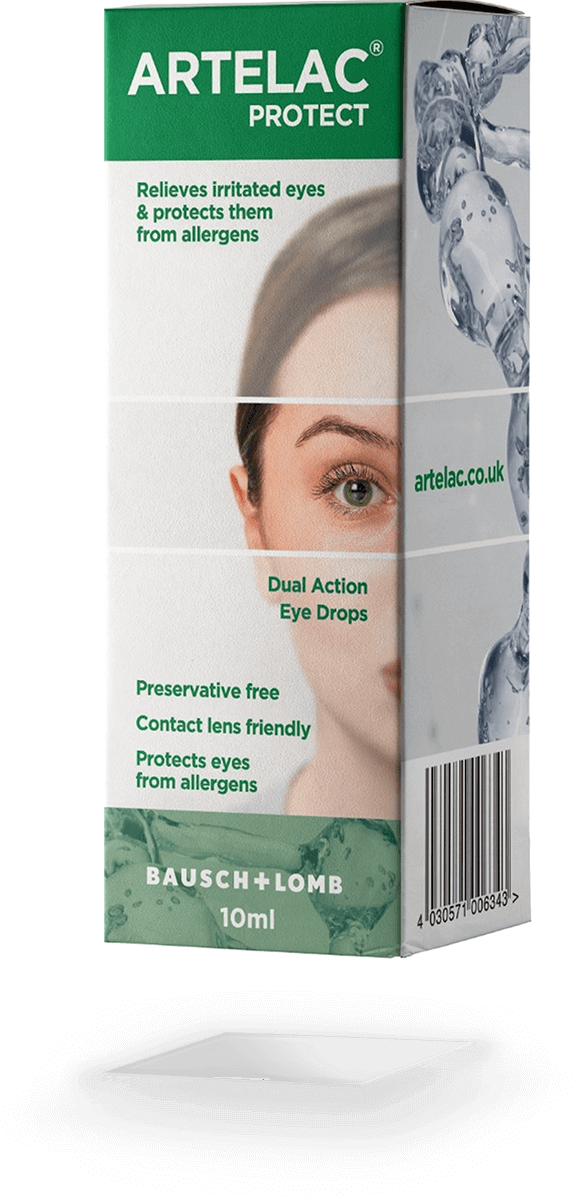There are many changes that take place when a woman goes through the menopause – dry eyes often being one of them. Dry eyes occur when there are not enough tears to keep the eyes lubricated – either through a lack of tear production or if tears are evaporating from the eye’s surface too quickly. This is commonly known as Dry Eye Syndrome. While it can be frustrating and uncomfortable, Dry Eye Syndrome can be easily managed and needn’t prevent you from doing any of the activities you love1 & 3.
Dry eye symptoms during the menopause
Many women say that when they are going through the menopause their Dry Eye Syndrome symptoms are often worse at the end of the day. This is particularly the case if they’ve been sitting in front of a screen or spent a lot of time reading during the day2.

Dry Eye symptoms include eyes feeling4:
- Itchy
- Sore
- Irritated
- Dry
- Uncomfortable
- Tired
Dry eyes caused by menopause may also look redder in appearance, become more irritated and vision may become slightly blurred.5 Some women may also experience a sensitivity to light.
How do hormonal changes affect the eyes?
Hormones play an integral role in the way you function so when they change, they naturally create a knock on effect on other parts of your body.
During the menopause there is an imbalance in the female sex hormones (androgen and oestrogen). These hormones influence the production of the components that keep eyes hydrated6:
- Lipid (Oil) Layer
- Aqueous (Water) Layer
- Mucin Layer
These three layers make up what is commonly known as the tear film. A change in the levels of hormones can impact the levels of the above components, resulting in a change to the eye’s tear film.
In fact, the changes in hormone levels during the menopause have such an impact that studies have shown that Dry Eye Syndrome in women over the age of 50 is almost double that of men of the same age6.
Some women may choose to have hormone replacement therapy (HRT) but various studies have shown that it does not appear to reduce the risk of Dry Eye Syndrome. In some cases, HRT can even increase the risk or make symptoms worse6. Therefore it is important to fully understand what can help and prevent the condition.
Agitating factors
While the change in hormones can bring on Dry Eye Syndrome there are other factors playing a part in our day-to-day lives which can agitate and aggravate our eyes. These include:
- Wearing contact lenses
Contact lenses can lead to the eye drying out as the thin layer of lens material on the cornea can split the tear film and result in its destabilisation.7
- Air conditioning and heating
Being exposed to air conditioning or heating can lead to chronic inflammation of the conjunctiva8 which causes eyes to become dry.
- Weather
Extreme hot and cold weather can negatively impact the eye’s tear film and exposure to the sun, dust and wind aggravate or speed up getting dry eyes9.
- Smoking
Smoking tobacco irritates and worsens dry eye and those who smoke are nearly twice as likely to have dry eyes as non-smokers10.
- Screen time
Looking at computer screens and devices for a prolonged period of time results in a low blink rate, making it easier for tears to evaporate11.
- Not enough omega-3
Studies have shown that omega-3 can help protect against dry eye, so if you’re not getting enough in your diet, it may be worth considering a supplement 12or introducing fatty fish in your diet such as haddock, salmon and tuna.
Treatment and prevention
Dry Eye Syndrome is very common and can be easily treated. There are some measures you can put in place to try and stop it from occurring13. These include:
- Placing a warm, damp wash cloth over your closed eyes will help make your eye feel more comfortable.
- Using a humidifier in your room or office will help keep moisture in the air and will mean your eyes won’t dry out so quickly from heating.
- Wearing sunglasses while outdoors will help to protect your eyes from the elements.
- Applying the 20-20-20 rule when using screens will give your eyes sufficient breaks and make sure you’re blinking enough. This is where you look at something 20 feet away for 20 seconds every 20 minutes14.
- Consider upping your intake of omega-3 through oily fish such as salmon and mackerel. Nuts, such as walnuts, and seeds, like flaxseeds, are also rich in the nutrient.
- Using a lubricating eye drop to help add moisture back into your eye.

- Give your eyes a rest from contact lenses and pop on your glasses.
- Make sure you’re staying hydrated by drinking plenty of fluid throughout the day15.
However, if you are still concerned about your dry eyes, it is always advisable to visit your GP or optician.
References
- Mayo Clinic: Dry Eyes. Available online at: https://www.mayoclinic.org/diseases-conditions/dry-eyes/symptoms-causes/syc-20371863 Accessed on: March 2020
- Sezen Akkaya, Tugba Atakan, Banu Acikalin, Sibel Aksoy, and Yelda Ozkurt, 2018. Effects of long-term computer use on eye dryness. NCBI [e-journal] 5(4), pp. 319-322
- Healthline: Menopause and Dry Eyes. Available online at: https://www.healthline.com/health/menopause/menopause-and-dry-eyes Accessed on: March 2020
- Medical News Today: What is dry eye and how can I get rid of it? Available online at: https://www.medicalnewstoday.com/articles/170743 Accessed on: February 2020
- The North American Menopause Society: Menopause and Eye Health. Available online at: https://www.menopause.org/for-women/menopauseflashes/women’s-health-and-menopause/menopause-and-eye-health Accessed on: February 2020
- Travis Peck, Leslie Olsakovsky, and Shruti Aggarwal, 2017. Dry Eye Syndrome in Menopause and Perimenopausal Age Group. NCBI, [e-journal] 8(2), pp. 51-54. https://www.ncbi.nlm.nih.gov/pmc/articles/PMC5496280/
- Miriam Kopf, Fan Yi, D. Robert Iskander, Michael J. Collins, Alyra J. Shaw, and Benjamin Straker, 2008. Tear Film Surface Quality with Soft Contact Lenses Using Dynamic Videokeratoscopy. NCBI, [e-journal], 1(1), pp. 14-21. https://www.ncbi.nlm.nih.gov/pmc/articles/PMC3972648/
- Mark I. Golden; Bhupendra C. Patel, 2019. Dry eye syndrome. NCBI [e-journal] 1, pp 1 https://www.ncbi.nlm.nih.gov/books/NBK470411/
- Johnny L Gayton, 2009. Etiology, prevalence, and treatment of dry eye disease. NCBI, [e-journal] 3, pp. 405-412 https://www.ncbi.nlm.nih.gov/pmc/articles/PMC2720680/
- WebMD: Smoking and dry eye. Available online at: https://www.webmd.com/eye-health/smoking-dry-eyes Accessed on February 2020
- Sezen Akkaya, Tugba Atakan, Banu Acikalin, Sibel Aksoy, and Yelda Ozkurt, 2018. Effects of long-term computer use on eye dryness. NCBI [e-journal] 5(4), pp. 319-322 https://www.ncbi.nlm.nih.gov/pmc/articles/PMC6371992/
- Jesús Tellez-Vazquez, 2016. Omega-3 fatty acid supplementation improves dry eye symptoms in patients with glaucoma: results of a prospective multicenter study. NCBI, [e-journal] 1, pp. 617–626 https://www.ncbi.nlm.nih.gov/pmc/articles/PMC4827597/
- Menopause Now: All About Menopause and Dry Eyes. Available online at: https://www.menopausenow.com/dry-eyes Accessed on: November 2019
- The Canadian Association of Optometrists: The 20-20-20 rule. Available online at: https://opto.ca/health-library/the-20-20-20-rule Accessed on: March 2020
- NHS: Water, drinks and your health. Available online at: https://www.nhs.uk/live-well/eat-well/water-drinks-nutrition/ Accessed on: November 2019

